You are reading the older HTML site
Positive Feedback ISSUE
41january/february 2009

HeadRoom's "Special" A
New Portable Desktop Amplifier
a review by
Max Dudious
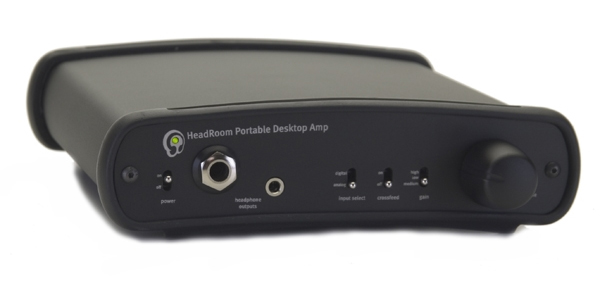
Now and then a product comes along whose designers seem to pick and choose the best features of previous designs (over the past fifteen or so years) and put them together in a new combination that synergistically makes them better than the "mere sum of their parts." HeadRoom's "Portable Desktop Amp" may be one, may be "special." Only time will tell. Please note I stress the word "portable" because portability brings a new design landscape to headphone amp building. Rarely, but on enough occasions to keep such audio wonders from seeming divine in origin, such synergy gives a quantum-level jump in performance. It is similar to 21st century industrial techniques that produce wines aged with oak-chips in stainless-steel, railroad tank-cars that (seeming a miracle) compare with prize-winning vintages developed through use of 19th century manual-pruning-techniques and in-the-oaken-barrel aging. But it does happen, if (alas) only sometimes. There are some audio legends that illustrate this notion, my favorite being as follows.
Illustrative Audio Legend:
When some audio designer wizards in their bronze age caves were making the transition from tubed to transistorized pieces, they found tube gear worked nicely with power supplies derived from textbook formulae, and even better if they doubled the size of the storage capacitors. But, if they quadrupled the storage caps they might sometimes place too much current draw on rectifier tubes and cause disasters. So there was a (not too much, nor too little) window of opportunity they had to shoot for when designing power supplies for tube gear.
With transistors, especially in the early days, the wizards could design a power supply that was theoretically correct at 0.5 amperes, and go to quadruple its storage caps and select parts as if designing for 2.0 amps draw. One day, the legend goes, while building a preamp that drew relatively low level amperage (say, half an amp), someone misplaced the freestanding 2 ampere power supply. They figured since no parts would be stressed with such low current draw, they could use any power supply that was larger than the design called for.
They reasoned they could temporarily use a discrete 10 amp supply (about enough for a small refrigerator/freezer) that was hanging around the castle dungeon used for testing 350 W power amplifiers, which were used to torture court musicians who got sloppy by forcing them to listen to Pachelbel's Canon repeatedly for weeks. They connected the giant power supply to the preamp that drew only 500 miliamperes and—lo and behold—the sound improved in every way. Rated at 10 amps, the supply was a twenty-fold increase in storage compared to the original textbook designed preamp supply. These wizards went on to over-design all the supplies in their line. And lived happily ever after. You might ask, "How do such things come about?" I'd answer, "Beats me. It's a mystery." But it's an audio legend.
Design Methodology:
That's the way some design improvements come about in audio. Over time, a good deal of information is passed around the industry and an oral tradition develops. Sometimes these legends make it into articles in The Learned Journals. After a while a canon of acceptable practices develops, such as: We find for audio it is best to use; 1% metal film resistors, with polypropylene or polyphenylenesulfide caps in the signal path; "Blackgate" caps in the power supply, "stealth" diodes in rectifier circuits, "six-nines" Ohno Constant Casting silver in internal wiring, FET transistors where possible, ceramic tube sockets where possible, discrete-step volume pots, etc. etc. Similarly, there are familiar circuit topologies that have proven themselves over time; for but three examples, push-pull-triode output stages (Williamson type) in tube amps, npn/pnp (complementary setups) in transistorized amps' output stages, and (Walt Jung's) "Diamond Buffer" output current amplifier. Ironically, as these also seem to be the ingredients of many unsuccessful designs, it seems the attention to fine-grain detail (such as parts' placement on PCBs, or printed circuit boards, to avoid cross talk), and hard listening to various passive parts, that make for incremental improvements over time, and get some products generally accepted as leading the pack.
HeadRoom's Design Method:
The "Portable Desktop Amp" is the result of HeadRoom's cherry-picking those preferred design features (such as, a battery power supply, a diamond buffer amp, and using highest-quality parts) through a "sixteen year long quest to build the world's finest portable headphone amplifier." I can't say the Portable Desktop is the one and only "world's finest" portable: rather, it is for sure among the "world's finest" that I've ever heard. It may seem I'm copping out, or equivocating here, but I would have to undertake an annual survey of all the headphone amps in production to say one of them is the "world's finest." I just don't have the time to conduct such a survey every year, and I don't think my job is to crown the heavyweight champ of headphone amps: it is, rather, to report on new developments in the field, and to express my enthusiasms. I try not to write negative reviews, as I feel that would be counter-productive to the whole reviewing enterprise. I will say this: The HeadRoom Portable Desktop Amp is "world class." It does everything you expect such an amp to do, and while it travels well, it also stays home well.
There are other non-portable amps in the HeadRoom line that I'm told outperform the Portable Desktop in the lab and right between your ears, but they don't have everything (amplifier circuit, battery power-supply, and DAC) on one chassis. This is the first product I know of that is relatively small, compact, and portable that shoehorns all the goodies onto one tight chassis. Designing for portability, I'm told, changes everything. It is the most demanding task in which to get everything right. HeadRoom's Portable Desktop Amp makes the fewest compromises, and it is reflected in the sound. At the MSLP of $1099, with all its features, the high quality of its build, and the extraordinary quality of its sound, I'd say it was a bargain you can take traveling.
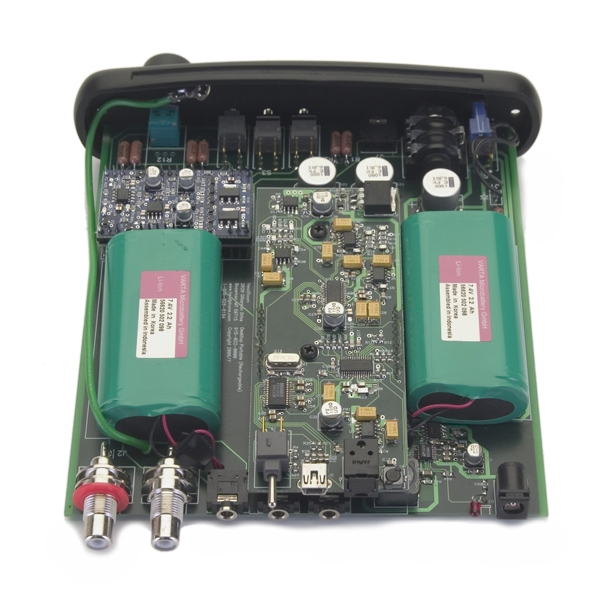
Batteries vs. Conventional Power Supply:
You need be only recently involved with audio when you notice that some damned fine pieces of gear have a separate chassis-box to house their A.C. power supplies. In the past, mostly, audible power supplies managed to color the sound in such a pervasive (if insidiously subtle) way as barely perceptible veiling such that we often confused power supply's sound for amplifier's circuit sound. Due to the considerable expense of a separate power supply, they are mostly found in the cost-no-object niche of the market. Recently, more very fine battery-powered preamps (like the Nagra PL-P) have made their way into production. Nagra products have often fallen into the best engineered, highest performing class. Given the difference in price, to say HeadRoom's $1100 Portable Desktop Headphone Amplifier shares some design decisions with Nagra's PL-P (about $6000 MSLP.) portable, on-location, recording preamp says a lot, and that puts these two into the same category with regard to one major element. (They each use a battery-driven power supply.) I haven't lived with a Nagra preamp in my system, so I don't know how many design options it shares with the HeadRoom, nor how it sounds exactly. I have heard it at shows, and it is (as Bill and Ted might say) "most excellent."
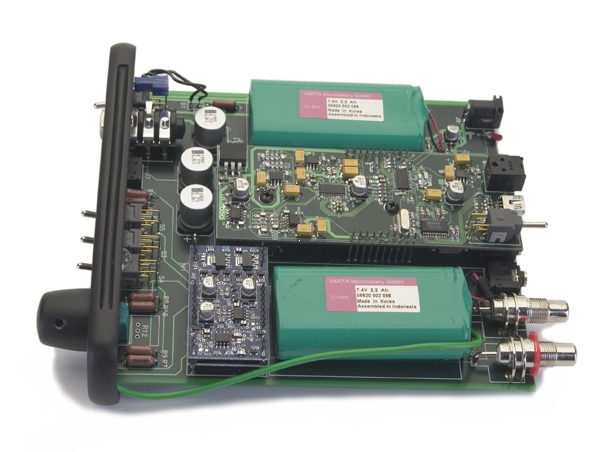
Less Is More:
Using a battery-powered supply eliminates an expensive transformer, filter caps, often an expensive choke, most of the time a costly bridge rectifier, not to mention a metal chassis-box and a faceplate that amount to more than chump-change. Such power supplies require space, can be a bit noisy, and may throw an electro-magnetic field sometimes experienced as hum. Also, some transformers vibrate annoyingly, while others may be susceptible to RFI invading their windings. It makes audio sense to put power supplies in a separate, well-shielded chassis-box.
One electronically redeeming quality is; as there are now empty chassis spaces where power supply parts would have gone, we can fill them with batteries and eliminate nearly all the usual power-supply cost, hum, and noise problems as well. (A curious aside: Stealth diodes are so named because older diodes would show spuriae on oscilloscope testing, while Stealth diodes did not. Spuriae unseen are spuriae unheard. The manufacturer, Fairchild, likened these new diodes to "Stealth" aircraft that were hard to track on CRT radar. Stealth diodes remove hazy veils from the signal path. As it has been written, "In the signal path, dioding sucks.") HeadRoom engineers, by choosing to eliminate the expensive power supply and build a battery-powered amp, have eliminated most sources of noise and veiling before they invade the signal path; and this is how less is more. Following HeadRoom's previous experience with portable amps, it was not difficult for them to design and build a slick, low-noise, battery-powered supply for a low-current output headphone amplifier.
How Does It Sound?
First off, "How does it sound as a preamp in a free standing stereo system?" I asked myself. And being small, it was no big thing to install it into my big-rig, my best free-standing stereo system. With the introduction of WireWorld AC cords and interconnect cables, my big system lately has been sounding better than I thought possible. When I substituted the HeadRoom Portable Desktop Headphone Amplifier for my Parasound Halo JC-2 preamp, there was little (if any) falloff in sound quality. If pressed, I might give the nod to the JC-2 in the realm of soundstaging, image size, and in dynamic startle-ability (zotz). But as these qualities may be room-dependent, and as most of us will be using the Portable Desktop with headphones, the slight differences seem negligible.
How does it sound as a headphone amp as compared with similar headphone amps? This was pretty easy. I am set up such that I could hear the Portable Desktop compared with Grado's portable (battery powered) SA-1, still serviceable after all these years with a detailed yet suave sound; or Ray Samuels' "The Hornet" (battery powered) suave yet crisply detailed sound; or Single Power's Slam PPX3 (onboard supplied—conventional), amazingly suave and tubey, with enough detail; or HeadRoom's full-bloom Millet Hybrid Headphone Amplifier (solid-state front-end, tube output; with choice of two outboard supplies—switching or conventional), the Millet is a great classical amp with a really large sound-stage with HeadRoom's Desktop Power Supply, and punchy enough for great rock coupled to HeadRoom's Astrodyne (switching) transformer. Listening to either a Radio Shack walk-around Optimus CD-3400, which can deliver audio in either damn good analog or (coax) digital mode; or, a Sony XA3ES CD player, which can also deliver in superior analog or (optical) digital mode, the Portable Desktop does very well to superbly with either of these CD players, so, I'd guess, it will with just about any CD player. By the way, if you can get a Sony XA3ES in good working condition from a pawn shop, it would be a great CD player to use as a dedicated front end for a system using the Portable Desktop, and a pair of high quality 'phones. Again, sometimes less is more.
I should say listening through the Optimus and Sony CD players' onboard DACs and through their analog stages, was damn fine; but listening through the HeadRoom's DAC and analog stages was like going between standard cable and cathode ray tube TV and then switching to Hi-Def signal and an LCD TV. The pictures are more detailed and have more three-dimensionality, even in black-and-white. For the nonce it should suffice to say, HeadRoom's Portable Desktop Amp played in combination with each of these CD players as well as I've ever heard them. Using its onboard DAC, with the Sony's bitstream, it played in the digital mode Telarc's latest recording of Vivaldi's The Four Seasons (SACD-60698) so beautifully I felt the recording engineering was more up for evaluation than the amplifier. More than with any of the other combinations, while listening to HeadRoom's Portable Desktop Amplifier plus its DAC, all the electronics "seem to disappear." Another way of saying it is; through the Portable's DAC and analog-amp the sound is sweet and great for classical music, while through the Portable's analog-amp alone, the sound is more detailed and great for Rock. It's like getting two amps for the price of one.
Another Corroborative Quotation:
You know, if you've been reading my purple prose these past years, I prowl the audio journals with an eye for corroborative information, sort of. This Portable Desktop preamp is a very high performer in my system when compared to a preamp that has established a solid reputation against all-comers like the Parasound Halo's JC-2. The Portable Desktop has such a pleasant and detailed presentation of music that, as Harry Pearson writes (in TAS; Feb. 2009): "There is the danger that as our audio equipment becomes ever more translucent we might find ourselves reviewing the recording technology rather than for us the essential, those colorations and lies told by our components." I find Headroom's Portable Desktop amp is in the class that makes it possible to convincingly evaluate a particular CD's recording engineering.
That is to say, the Portable Desktop might be among the first pieces of headphone gear that truly takes us back to the recording studio by releasing us from the tyranny of compound colorations introduced to our free-standing systems by AC cords, interconnect cables, speaker cables, amps, and preamps, not to forget CD players, nor turn-table/tone-arm/cartridge rigs. Listening to a well-engineered CD through the shortest path; a good CD player, the Portable Desktop, and a pair of Grado GS 1000's, or Sennheiser 650's (with Cardas cables) gets me closer than ever to the recorded music. This Portable Desktop represents a real jump in performance, and I expect it may be the top of HeadRoom's Portable line for some time.
With apologies to those who treasure Thomas Jefferson's aphorism, "That government governs best that governs least:" I'd paraphrase and say, "That headphone amp colors best that colors least." The Portable Desktop allows me to hear details far down in the mix, as on the recent Telarc recording of Vivaldi's The Four Seasons, where I can hear the air-conditioning system in the spaces between the notes on slow passages as differing from the truly silent cuts between the various movements of the music. That's down in the mix! And it lets you know, when playing silent cuts, there is no audible noise in the circuitry. Not to say other amps can't get that, but they are often not as suave on other musical details; such as, soprano friendliness, violin fingering noises, spit in the reed of saxophonists, etc. This amp is accurate and beautiful. It doesn't bring up the violin's fingering, nor the sax's spit in an in-your-face way. You have to seek out those sounds. I think the battery-operated power supply is responsible for much of that. Don't forget the same batteries supply the current to the onboard DAC and its audio circuit. They are 4 cell, rechargeable Lithium batteries, by the way. And you get the first pair included in the purchase price, but you get a second pair for free (though you do have to pay to ship the amp back and forth to Montana).
The DAC:
This seems an apt place to offer a few words concerning the Digital-to-Audio Converter. HeadRoom has had its share of experience with stand alone DACs, as well as onboard DACs, have done their share of trials and errors on this front. I'm sure no one at HeadRoom would say it, but it seems likely one of those trials, as in our legend, generated a lot of mysterious sounds that turned out to be palms on foreheads, and startled voices exclaiming, "Why didn't we do this before?" Well, better late than never.
Having a DAC printed circuit board inside a preamp seems a natural: you save the money of building a separate-chassis stand-alone unit, and you can have it draw its small amount of current from the same battery-driven power supply. This avoids clock-jitter and the etched sound common to the audio board of most free-standing DACs, and it's way less money than three separate chassis boxes (DAC, Supply, and Circuitry). According to the owner's manual:
"The Portable Desktop DAC is a clean, well-balanced, and natural sounding converter. It uses the Cirrus Logic's flagship CA4398, 24bit/192kHz, 120dB dynamic range digital to analog converter. Coupled with extensive power supply isolation and regulation this DAC will take virtually any digital source and turn it into a quality listening experience.
The Portable Desktop DAC board uses the well regarded Burr-Brown 134 in single packages; only metal thin film resistors and polyphenylenesulfide (poly film) capacitors are used anywhere near the audio circuits. Three low-noise, ultra-low dropout power supply regulators isolate the various digital, analog, and mixed signal circuits."
Obviously, Tyll Hertsens and his team of engineers have been learning as they go. And while the attention in the above paragraphs is on the parts quality and placement of both the digital handling and audio circuits, I have a hunch the battery power-supply has a lot to do with the sound, which is superior (according to my aging ears) to anything they have offered before: Smooth enough for classical; punchy enough for rock. So, by bringing both the battery-driven power-supply and the DAC onboard, they have saved the price of two more separate chassis-boxes (the power supply's and DAC's), while they have greatly improved the sound (much more than one or two "just noticeable differences"). I expect to see many manufacturers include a DAC in their preamps soon, especially in Home Theater systems. "Kudos" to Tyll. And, "Good job, guys." to everyone associated with this super little box. The top-off pix were astonishing. Talk about shoe-horning ten pounds of parts into a five pound chassis! Make that, "Great Job!!"
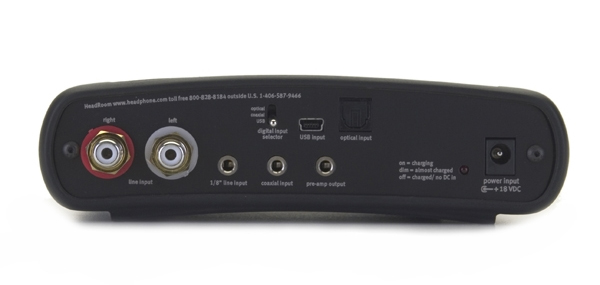
Other Features:
Twin RCA analog receptacles, 1/8" stereo analog mini-plug receptacle, optical digital receptacle, coax digital receptacle, and USB digital receptacle, all on the rear where they belong; along with a selector switch for choosing digital input, and an 18 VDC power input.
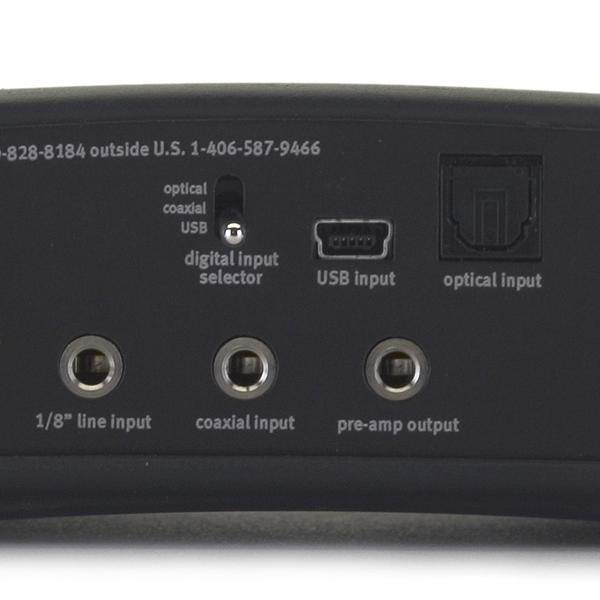
Re-Charging Batteries:
A few words here about battery re-charging: The earliest models of this piece were set up so you couldn't listen to music while the batteries were re-charging. That meant, if you were taking a trip you had to remember to run the batteries all the way down, and then set the piece aside where you could attach it to the "wall wart" that supplies the D.C. current. A complete re-charge would take around four hours. Then you were O.K. to fly off, sometimes known as "Good To Go." But while the usable charge might get you to from the East Coast to the West Coast, or maybe to London, you'd might run out by the time you reached Vienna or Beijing. Of course, this is variable. It depends at what impedance (or efficiency) your headphones operate, and whether or not you listen through the DAC plus the analog amplifier, or only the analog amplifier.
High impedance headphones (like Sennheiser's 650, some AKGs, and some others) will use up a charge more quickly than, say, low impedance 'phones (like Grado's line), or most in-the-ear-canal 'phones. High impedance 'phones might cut in half the useful time of your charge, depending on how loudly you like to listen. Furthermore, using the onboard DAC might halve (again) the time of your charge. That means, using the DAC and high impedance (or low efficiency) 'phones will use up your charge relatively quickly. With high efficiency 'phones, and no DAC, you might expect a charge to last up to twenty hours. (You can do the math for the other possibilities.) So, Santa and his helpers decided to modify the circuit so you could play music and re-charge at the same time. Make sure you specify that you want the "2009-W" model when you order over the phone. If anyone asks what you mean by "W," you say, "You know who W stands for." If they ask you what you mean by that, you say, "I want the model that can play and re-charge at the same time; like some politicians, of whom it was said, 'He could chew gum and walk down a flight of stairs at the same time.'"
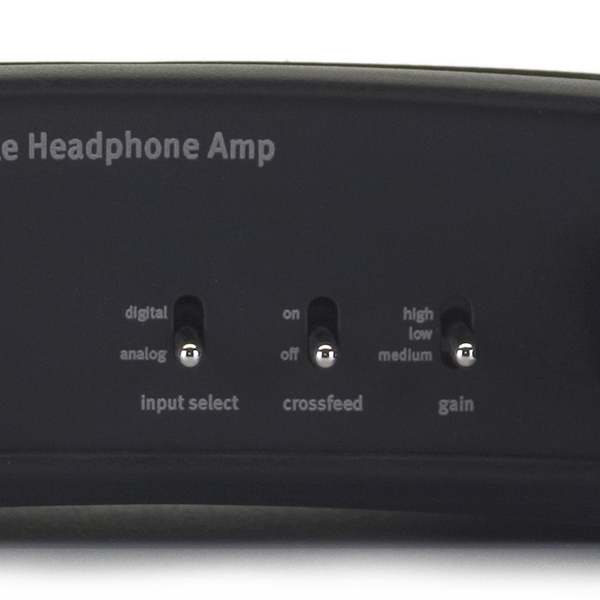
On the front panel is the on-off switch and L.E.D, a 1/4" and a 1/8" input for headphone jacks, a smooth volume control, a digital/analog input selector switch, a hi/lo/med gain selector switch (for 'phones with markedly different outputs), and a crossfeed switch. Regarding "crossfeed," I've a few paragraphs on that.
Crossfeed:
I'm a bit of a Luddite. I'm often against (if one can be against circuits) new things like cell-phones used by drivers, and "Loudness" and "Filter" switches in sound systems; so I started out being against crossfeed. I wasn't against it in an unthinking way, as I had given it more than a little consideration. If the goal of audiophiles is to get the closest to the original performance, then why spend so much engineering skill (time, money) to get a headphone amplifier just as free from distortion and artifice as possible, and then crossfeed the left and right channels? I found it unacceptably contradictory. And then, once in a while, I'd finger that little switch, and damned if I didn't feel its seductive appeal. Though a chill went up my spine, I couldn't embrace crossfeed all at once, or I'd've felt like Senator Joe Lieberman, who left the Democratic Party to become an Independent, a turncoat.
Still, like Mary, there was something about crossfeed. What could explain this? I now think it is another of the mysteries of audio: it oughtn't to make a difference, but it does. The difference oughtn't be a good one, but it is. How could such things come about? Beats me. It's a mystery! One way to think of it is this: a symphonic recording, with its microphone placement, usually manages to pick up hall reflections that are mimicked, in turn, as room reflections by a free-standing system in a listening room. Crossfeed simulates those early reflections in headphones. To be against crossfeed, I might as well be against the whole of the recording process and only listen to live performances. Today I feel crossfeed gets us one step closer to the ultimate facsimile of the original musical event, and I wouldn't leave home without it. I'm flexible. I'll kneel to the best technological improvements. I also feel 5.1 Surround Sound, at its best, can correct for bad listening rooms. Though I do my best listening in my "good room" with my stereo-only big rig, because it is the closest to being in my favorite seat in Baltimore's Meyerhoff Symphony Hall.
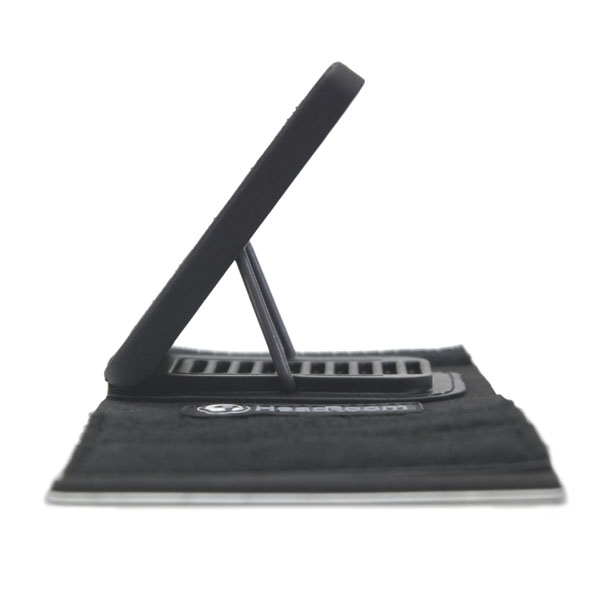
Accessories:
If you go to www.headphone.com and click on, and search for the Portable Desktop Amplifier, and then click on to "Accessories" for this piece, you'll find a few items of interest. One is a "strap" and it amounts to a wrapper that fits snugly to this piece. When properly oriented you can use it to Velcro an I-pod to a platform you can tilt up 45 degrees to see what is going on in your world. I use it as a base for my CD player. Strapped in place it provides a flat platform for an Walk-person CD player without rocking to either side because the Portable Desktop has a slightly rounded top. With this accessory, the CD player won't slide around as you change CDs, so I found it a pretty nice touch, to stack the CD player atop the amp. Another thing worth its price is a carrying case: It will protect the finish if you're going to travel a lot. All such things can be seen at HeadRoom's website, with its address above. You can order HeadRoom's products by phone. The number is: (800) 828.8184 . When you phone 'em up, tell em Max Dudious sent you. If you're looking for a dynamite sounding amplifier that doubles as a travel and desktop piece, I'm pretty sure you can't do any better than HeadRoom's Portable Desktop Amp. It is really pretty fine. Best In Class. Ciao Bambini, on Feb. 2nd, 2009, Groundhog's Day. Any excuse for a party.
Max Dudious: Party Animal!
Ciao, Bambini.
